Quick Summary:
The comparison between Data Lake vs Data Warehouse, lies in their roles in the data management. A Data Lake is a versatile repository for raw & diverse data, fostering flexibility in analytics. On the other hand, a data Warehouse is structured for efficient storage & retrieval of organized data, specially geared towards business intelligence & analytical reporting, streamlining structured data analysis.
Organizations struggle with the pivotal choice: the ideal method to organize, store, and analyse the large volume of data. At the heart of this decision-making process lies two important components: Data Lake and Data Warehouses. Each of these repositories possesses different approaches to handling data.
Think of a Data Lake as a large pool of diverse data, allowing unparalleled flexibility in analysis. In contrast, a Data Warehouse is like a well-structured, purpose-built warehouse to retrieve, search, and analyse structured data.
This blog begins by exploring the complexities of Data Lakes and Data Warehouses inside, explore their importance, unique value and critical role in shaping organizational data-driven success Join us on this enlightening journey into the dynamic Data Warehouse strategy, empowering organizations to build informed decisions that allow for appropriate and impactful use of data.
Data Lake vs Data Warehouse: An Overview
Before we dive deeper into the details of Data Lake, it’s essential to take an overview of both the data storage system.
What is a Data Lake?
A Data Lake serves as a cluster storage space, accommodating vast amounts of both unstructured and structured data in its raw form without requiring a predefined schema. This flexibility enables organizations to consolidate diverse data types, facilitating powerful analytics and knowledge extraction. Despite their advantages, traditional Data Lakes present challenges like quality control issues and corruption.
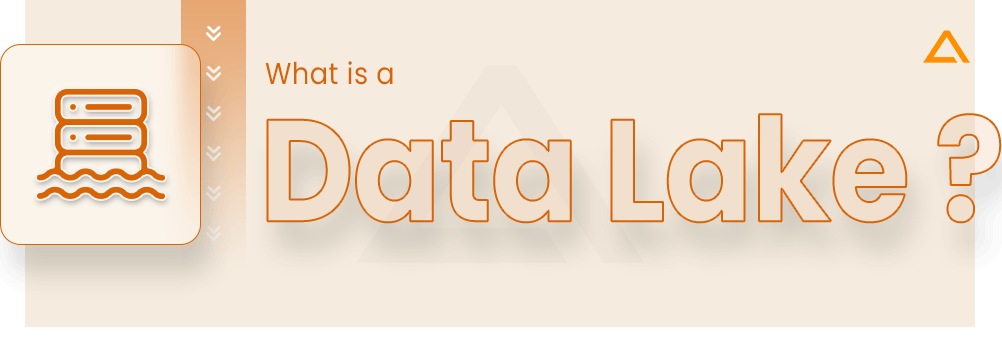
Enter Data Lakehouse, an open standards-based storage solution that solves these challenges. It meets the needs of data scientists and engineers for deep analytics, and traditional Data Warehouse professionals for business intelligence and reporting Lakehouse works seamlessly in a Data Lake, eliminating the need to duplicate data in a newly configured database in. This ensures up-to-date data for all users, while reducing redundancy and keeping the data consistent.
Features of Data Lake
- Unified Storage
- Schema Enforcement
- Query Performance
- Data Governance
- Real-time Analytics
- Cost Optimization
- Integration with BI Tools
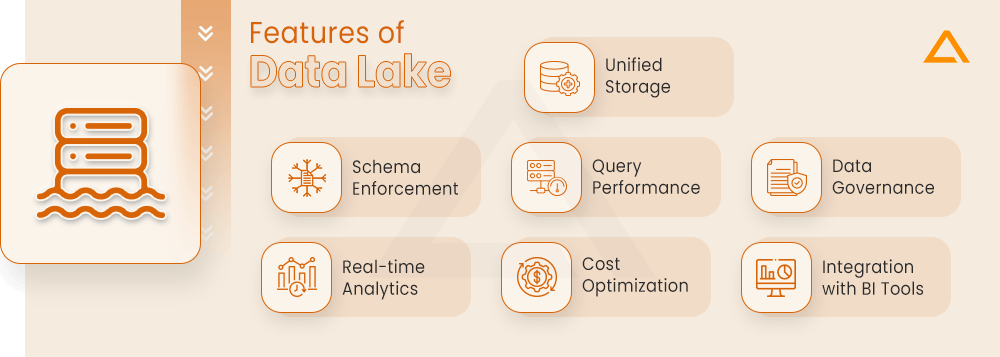
Architecture of Data Lake
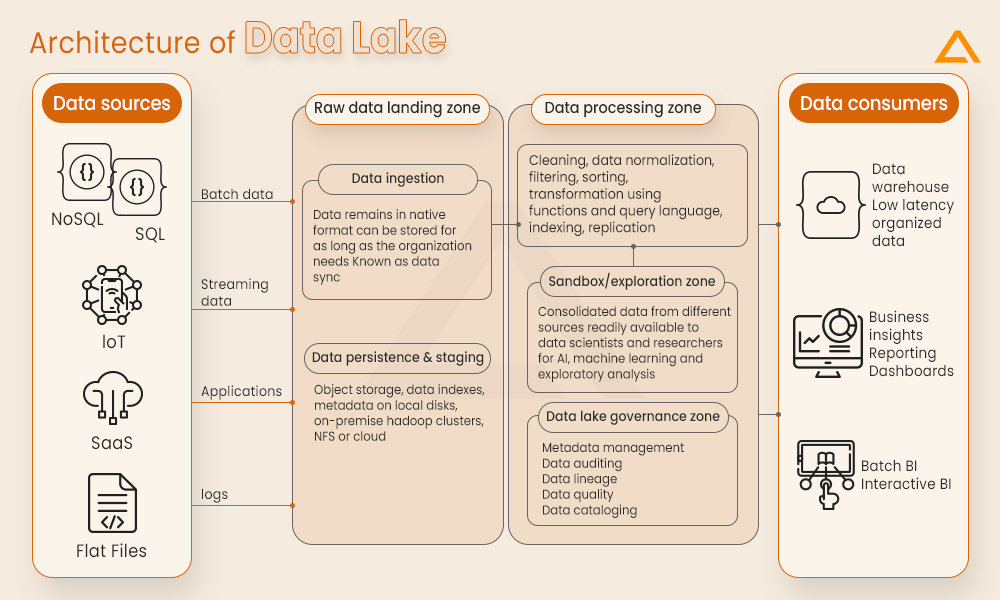
The architecture of a Data Lake serves as a structured framework for creating a centralized repository capable of storing and handling data in its native form, lacking of any predefined schema. It accommodates diverse forms of big data, including structured, semi-structured, and unstructured formats. The fundamental organization of a Data Lake involves the explanation of distinct zones.
- Raw data landing zone: This zone has data sourced from multiple sources comes here.
- Data Ingestion zone: This zone has data stored in its original format.
- Staging and Processing zone: This zone has Data transformed and enhanced for use.
- Exploration zone: This zone has data that scientist can use for research.
- Data governance zone: This zone deals with Data quality & auditing and metadata management.
Key Data Lake Components
Unlocking significant benefits, the Data Lake excels in its capacity to store data in its original state, irrespective of type, volume, or format. This facilitates seamless consolidation and analysis of varied datasets, offering valuable insights for business purposes and analytics, thereby empowering informed decision-making. A strategic design approach is crucial to maximize these advantages, encompassing key concepts outlined below.
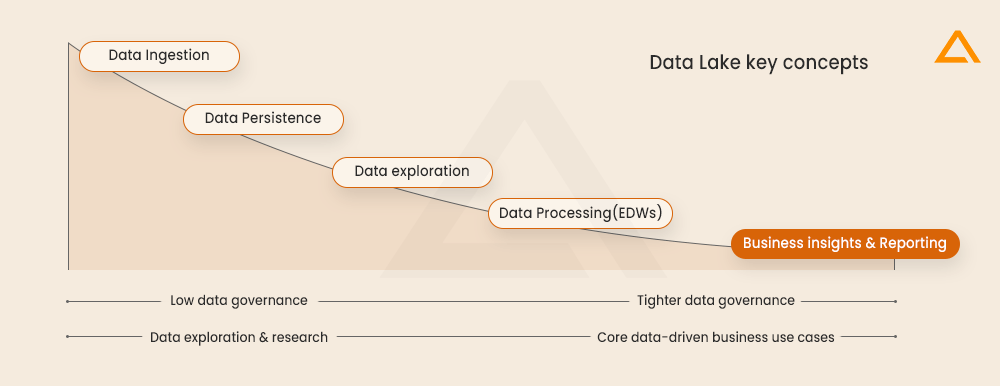
Data Ingestion
Data Ingestion, referred to as the landing zone, serves as the collection point for data originating from diverse sources such as NoSQL or SQL databases, getting data from IoT devices, logs, applications, and services. At this stage, the data remains in its raw format, exactly as received from the sources. Requiring minimal governance, this raw data is suitable for pilot projects and defining business requirements.
Data Persistence
The batch data obtained from databases, Data Warehouses, or other data stores undergoes storage in object storage. During this persistence process, it is imperative to retain information about the data, known as metadata. Additionally, implementing indexing mechanisms for data and metadata is essential to facilitate swift and efficient data searches.
Data Processing
Processing streaming data sourced from IoT messages, web applications, cloud-hosted services, and application logs involves ETL (Extract, Transform, Load) operations for standardization. Standardization is achieved through functions and queries, encompassing feature extraction, cleansing, sorting, aggregation, normalization, indexing, and data replication. The resultant refined and enriched data, referred to as authentic data, is stored in Enterprise Data Warehouses (EDWs). This data is utilized for specific use cases and lines of business, necessitating stringent data governance.
Data Exploration & Analysis
Data exploration and analysis empower data scientists and business analysts to utilize transformed or raw data, individually or in tandem, for developing machine learning models, AI applications, and exploratory research. This democratization of data access enables non-specialists to independently analyze and leverage data for informed business intelligence.
Data Governance
Ensuring adherence to policies like security, controlling access, monitoring data lineage, upholding data quality, conducting data audits, managing metadata, and cataloging data is essential to data governance. While raw data demands limited oversight, the transformed data tailored for distinct objectives seamlessly integrates into the central Data Lake framework, calling for heightened governance protocols.
Data lineage
A key advantage of employing a Data Lake lies in its capability to preserve data lineage. This entails tracing the trajectory of data from its initial form to its transformed state where it finds application. By embracing data lineage, entities can attain a holistic comprehension of the data’s path, encompassing its inception, alterations in the data pipeline, and eventual endpoint. This empowers organizations to uphold the quality and precision of data across its entire existence, delivering enhanced reliability and utility.
Data Cataloging
Data cataloging includes organizing the entire data set with the help of metadata and labels, and data relationship diagrams. This allows data users to quickly search for desired data in an integrated manner. In addition to the results of data analysis in a data catalog containing a mixture of raw and structured data, reports, query results, visualizations, and dashboards, the data catalog has the potential to facilitate the tracking of the data family.
Benefits of Using Data Lake
- Versatile data types
- Can handle large volumes
- Cost-effective storage
- Can store raw data without predefined schemas
- Offers support for advanced analytics
- Capabilities of data exploration and discovery
- Consolidation of data from various sources
- Real-time data processing
- Enhanced collaboration with centralized storage
- Data governance features when needed
- Support for multiple workloads
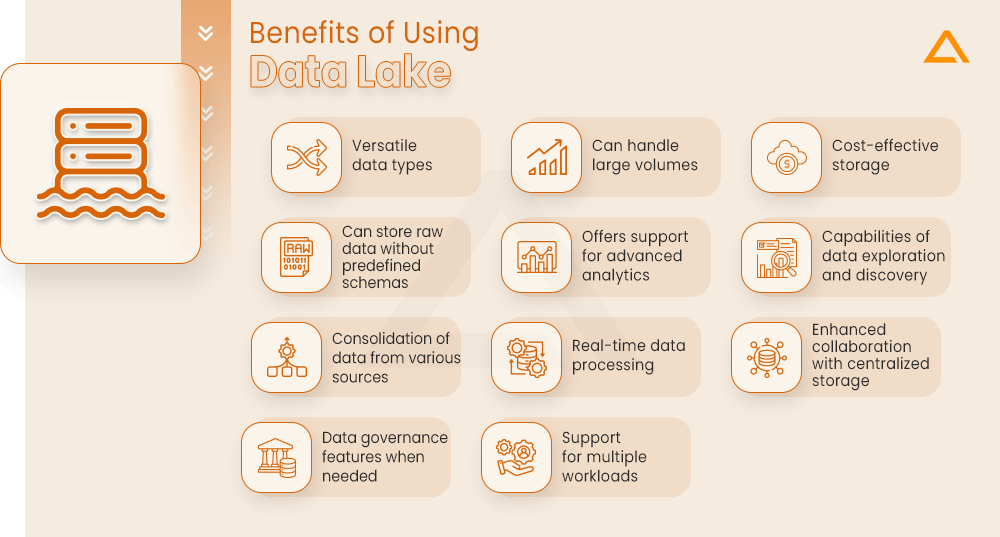
Types of Data Lake
There are various types of Data Lake:
- Structured: These types of Data Lake contain structured data from relational databases i.e. rows and columns
- Unstructured: These types of data contain the unstructured data from emails, documents, PDFs
- Semi-structured: These Data Lake type contains semi-structured data like CSV, logs, XML, JSON
- Binary: This is the type of Data Lake where images, audios, and video are stored

Use Cases of Data Lake
Some of the use-cases of Data Lake are as follows
- Cybersecurity
- Education
- Government
- Healthcare
- Transportation
- Genetics
Tools Used in Data Lake
Some of the popular Data Lake tools are as follows
- AWS Lake Formation
- Azure Data Lake Storage
- Google Cloud
- Spark Apache
- Qubole


Hey✋ Looking for Data Engineering Service? 👀🌟
Revolutionize Your Data Infrastructure with Cutting-Edge Engineering Services from Aglowid IT Solutions!
What is Data Warehouse?

A Data Warehouse serves as an extensive repository for organizational data, aggregating information from diverse sources for meaningful business insights.

Acting as a transformative process, raw data is processed and organized, creating structured, pre-filtered data ready for historical analysis and advanced queries. This centralized information hub encompasses details about products, orders, customers, employees, and inventory, facilitating data sharing across department-specific databases. Entrepreneurs and business users serve as the primary end-users, harnessing the power of a Data Warehouse for informed decision-making.
Features of Data Warehouse
- Structured Data Storage
- Data Integration
- Query & Reporting
- Data Transformation (ETL)
- Metadata Management
- Security & Scalability
- Data Quality Assurance
- Concurrency and Performance
- Backup & Recovery
- OLAP (Online Analytical Processing)

Architecture of Data Warehouse
Data warehouses comprise distinct functional layers, each designed for specific purposes within the architecture. Typically, these layers include the Source, Staging, Warehouse, and Consumption layers.
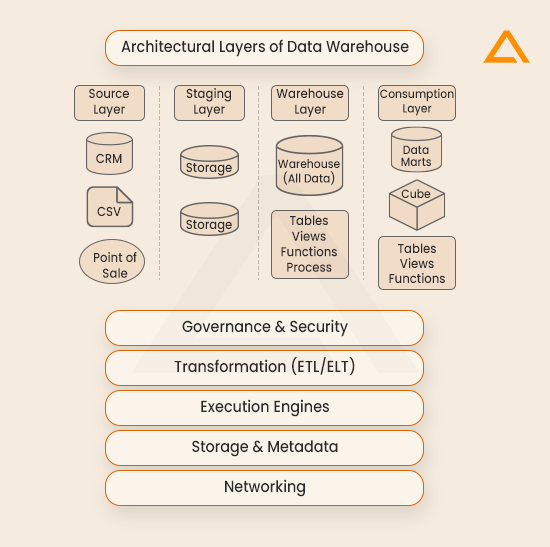
Source Layer
This initial layer encompasses all Systems of Record (SOR), such as CRM, ERP, marketing automation, or point-of-sale systems. Each SOR contributes data to the warehouse, with specific formats requiring unique capture methods.
Staging Layer
Functioning as a data landing area, the staging layer receives raw data from SOR without applying business logic or transformations. It is crucial to refrain from using staging data for production analysis, as it awaits cleansing, standardization, modelling, governance, and verification.
Warehouse Layer
The central layer where all data is stored in a subject-oriented, integrated, time-variant, and non-volatile manner. This layer encompasses physical schemas, tables, views, stored procedures, and functions necessary for accessing the warehouse-modelled data.
Consumption Layer
Also referred to as the analytics layer, this is where data is modelled for consumption by utilizing analytics tools like ThoughtSpot, involving data analysts, data scientists, and business users in the process. Each of these layer plays a important part in the overall efficiency and functionality of the Data Warehouse architecture.
Benefits of using Data Warehouse
- Centralized Data Repository
- Improved Data Quality
- Enhanced Data Accessibility
- Historical Data Analysis
- Faster Query Performance
- Support for Decision-Making
- Integration of Disparate Data Sources
- Business Intelligence (BI) Capabilities
- Increased Operational Efficiency
- Compliance and Security
- Facilitation of Data Mining and Analytics
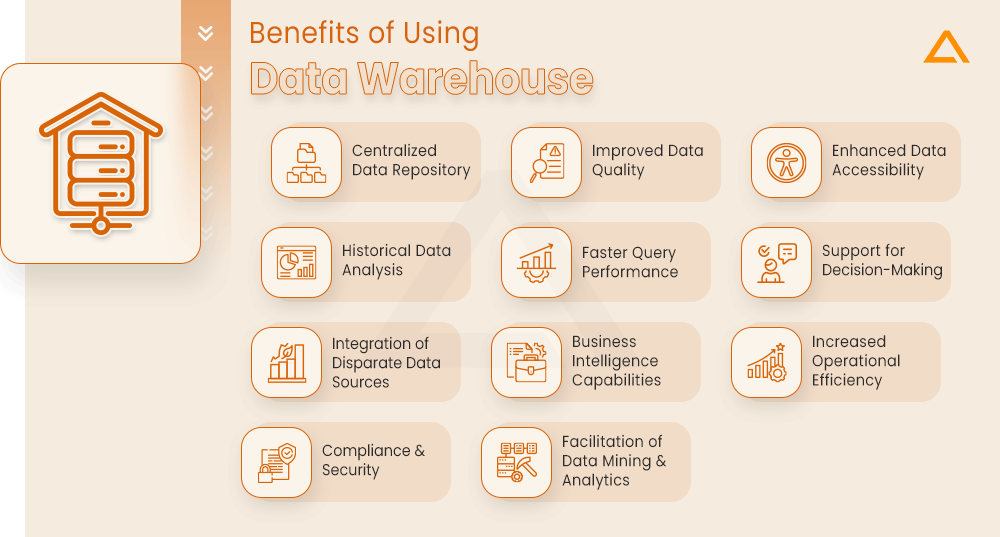
Types of Data Warehouse
There various types of Data Warehouses available. Three major types of Data Warehouses are as below.
Enterprise Data Warehouse
The Enterprise Data Warehouse (EDW) stands as the primary backbone of the data infrastructure. Acting as a centralized database, serving the primary function of providing the broad range of data needed for enterprise-wide decision support services focused on the inter-organizational environment, EDW ensures information flows across departments internally with ease, providing a comprehensive and integrated view of the organization’s data.
What sets EDW apart is its robust ability to process complex queries, allowing valuable insights to be extracted from the data collected. This makes it an important asset for strategic decisions within the company.
Operational Data Store
An Operational Data Warehouse (ODS) is a dynamic Data Warehouse architecture, characterized by real-time updates that support routine tasks and ensure immediate availability of data Going beyond just data storage, ODS play an important role in maintaining data quality and integrity.
It proactively scrubs and checks for redundancy, assuring that the stored information is clean, accurate and ready for use. As an integration hub, ODS excels at integrating a variety of data from multiple sources. This integration is key to creating unified and unified data that supports business operations, analytics and seamless reporting.
Data Mart
In contrast to a broader EDW, a data mart represents a more focused and specialized subset of data. It is designed to reach the specific needs of a particular department, segment, or industry, Data Mart excels at providing advanced responsiveness. By collecting and managing data on specific fields, it ensures that users have fast and targeted access to important data sets.
Notably, data marts cannot operate in isolation; Instead, it works in conjunction with EDW through ODS. Periodically, it feeds archived data back into EDW, providing valuable insights into the broader enterprise-wide data. This collaborative approach ensures that both uniqueness and comprehensiveness are maintained in the organization’s data infrastructure.
Use Cases of Data Warehouse
Some of the use-cases of Data Warehouse are as follows
- Finance & Banking
- Hospitality Industry
- Public Sector
- Laboratory
Tools of Data Warehouse
Here are some of the best data warehouse tools that are scalable:
- Amazon Redshift
- Microsoft Azure
- Google Big Query
- Amazon DynamoDB
- Micro Focus Vertica
- Snowflake
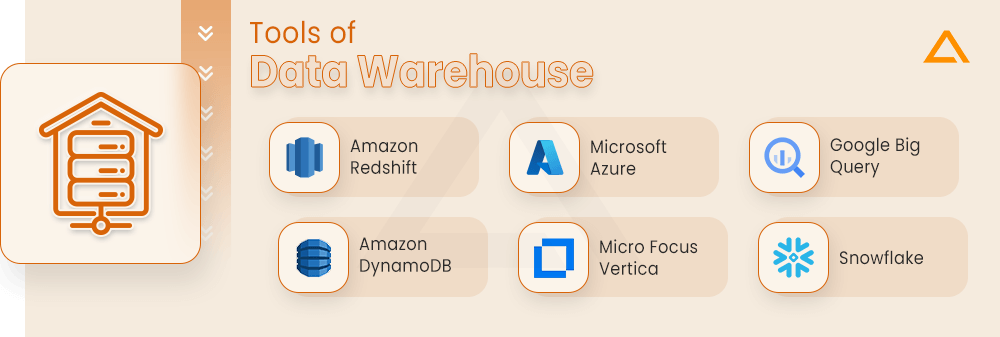
Now that you have an overview of both the storage strategies. Let’s dive into the difference between the Data Lake vs Data Warehouse.
Data Lake Vs Data Warehouse: A Tabular Comparison
Explore the tabular difference between Data Lake and Data Warehouse below:
| Features | Data Lake | Data Warehouse |
| Data Volume | Handles massive data volumes | Handle structured data volumes |
| Data Processing | On-demand data processing | Batch data processing |
| Data Agility | Handles varied data formats seamlessly. | Demands preprocessing for data storage. |
| Data Insights | Uncovers new patterns in raw data. | Uncovers new patterns in processed data. |
| End-Users | Serves data scientists and analysts with flexible queries. | Supports structured queries for business analysts and decision-makers. |
| Scalability | Horizontal Scale | Vertical Scale |
| Data Governance | Governance is essential to avoid data chaos and duplication. | Ensures governance for well-structured data. |
| Real-Time Processing | Supports real-time data streams | Limited real-time data streams |
| Examples | Hadoop | Amazon Redshift |
| Data Timeline | Archives data for both current and historical purposes. | Significant time allocated to analyze various data origins. |
| Data Capturing | Captures diverse data in its raw, unchanged formats. | Organizes structured data for the warehouse. |
| Security | Lower | High |
Data Lake & Data Warehouse: A Detailed Comparison
For most organizations, Data Warehouses are the primary repository of data, with cloud Data Warehouses increasingly popular. On the other hand, Data Lake are gaining popularity among data scientists in tasks such as machine learning and flat file analysis.
Many companies take a two-pronged approach, using Data Lake and Data Warehouses to meet data storage needs. To bridge the gap and leverage the strengths of each, some organizations are adopting integrated solutions called Data Lake building. Let’s explore the differences between Data Warehouses and Data Lake and explore how their combined uses provide a comprehensive data storage strategy for businesses.
Data Storage
One of the important differences between Data Warehouse vs Data Lake is Data Storage. Data Lakes act as repositories for unprocessed data from various sources such as IoT devices, user data, real-time social media streams, and web connections This unstructured data, with different formats, requires storage a it is abundant in Data Lake The Data Lake is unmanageable due to lack of flax measures Mud can occur.
In contrast, Data Warehouses store specially structured data that undergo preprocessing and refinement, and adhere to relational schemas. This historical phenomenon is well suited for systematic analysis against predefined business needs. Data Warehouses prioritize storage efficiency by excluding non-traditional resources such as web logs, sensor data, social media content, text, and images.
Users
Second difference between Data Lake vs warehouse is users usage. Data lakes are attracting greater usage from data scientists who are drawn to the raw and unstructured nature of storage, facilitating deeper analysis and unique business insights On the other hand, the Data Warehouse consumes business analysts, business customers, managers, project managers, and end-users who are aware of the data representation processed This role derives insights from business Key Operations Indicators (KPIs) internally, which benefit from pre-generated data designed to address specific analytical questions
Analysis
Next on the list of difference between Data Lake versus Data Warehouse/strong> is Analysis. Data engineers often use scalable unstructured data stored in Data Lakes to analyze big data. Data Lakes and Data Warehouses differ in their approaches. While Data Warehouses organize structured, processed data for historical analysis, Data Lakes leverage services like Apache Spark and Hadoop for big data analytics.
Data Lakes enable predictive analytics, data visualization, machine learning, business intelligence, and extensive big data analysis, showcasing a more flexible and scalable approach compared to the structured nature of Data Warehouses. Cleaned and archived data stored in Data Warehouses is often configured to be read-only for research users. Generally, it provides data visualization for further use with the best data visualization tools, BI, and data analytics.
Schema
One if the important difference between Data Lake and Data Warehouse is Schema. Once the data is stored in the Data Lake, the structure is defined; These speeds up the process of capturing and storing data. In addition, the Data Lake uses a schema-on-read approach to process data.
A schema is defined before the data is stored in the Data Warehouse; This increases the processing time of the data. But once the data is processed and stored in the warehouse, it’s ready for permanent, reliable use across the enterprise. In addition, the Data Warehouse uses a schema-on-write approach to process data and provide its shape and structure.
Processing
Data Lake uses the ELT (Extract Load Transform) process to extract data from its source and transfer it directly to the Data Lake without any changes. Data will only be processed when necessary. Data Warehouses use an ETL (Extract Transform Load) process, where data is extracted from its source, stored or organized, and finally loaded into the warehouse


Cost
Data lakes are cheap data storage, because the data is not processed. Additionally, less time is spent managing data, reducing operational costs. On the other hand, Data Warehouses are more expensive than Data Lakes because the data stored in the warehouse is cleaner and better organized. Additionally, more time is required to manage data which increases operational costs.
Tasks
Data engineers utilize Data Lakes not just for storage but also for accommodating incoming data. Unstructured and flexible, Data Lakes are ideal for big data analysis, especially with tools like Apache Spark and Hadoop, facilitating tasks such as deep learning that demand adjustments as training data expands. In contrast, Data Warehouses are often configured in read-only mode for analysts, designed for reading and storing clean data without the need for constant loading or updating.
Data Type
Data hygiene is a fundamental skill of data because data naturally comes in a messy and incomplete form. Unstructured raw data is called unstructured data—including most of the world’s data such as images, conversation logs, and PDF files.
Structured data is the unstructured data that is arranged in the tables and are defined by the data types. This is the main difference between pools and warehouses.
Data Lakes collect data from a variety of sources, including IoT devices, real-time social media streams, user data, and web application actions. Sometimes this data is sorted, but often, it’s very messy because the data is entered directly from the source of data. Data Warehouses, on the other hand, Data Warehouse contain historical data that is purified to conform to a relational model.
Data Lake vs Data Warehouse: When to Use Which?
Data lakes and Data Warehouses have importance and purposeful uses, but people are still confused about what should be used where. To better understand this, organizations must first understand their business model and its needs. Imagine the organization’s goal is to understand its business strategy and analytics or to launch something new based on past customer insights.

In that case, a warehouse may be the best option. On the other hand, if there is a need to study a huge amount of raw, granular, structured and unstructured data which is essential for AI/ML and deep learning data, then a Data Lake would be the best choice for a store.
When to Go for Data Lakes?
- You don’t know what kinds of data you need to keep in the past
- The data is messy and is difficult to fit into a tabular or relational model
- The number of data sets continues to grow, and storage costs are a concern
- The relationships between data elements are not already known
- The project involves the creation of a complete raw dataset, which is primarily used for data analytics, predictive analytics and AI/ML projects
When to Go for Data Warehouse?
- You already know what types of data you need to collect, and companies are uncomfortable with duplicated or irrelevant data
- Changes to data structures are extremely rare, and companies insist on standardized reporting to ensure accurate results
- The work requires structured data sets, especially for commercial, banking, and government-related industries
Data Lake vs Data Warehouse: When Not to Use Which?
Navigating the data landscape requires an understanding of when not to use Data Lakes or warehouses. In some cases, deviations from these solutions are most important for customized data use aligned with organizational objectives.

Data Lakes is Not the Right Choice When?
- Complex on-premises deployment requires careful planning for efficient
data integration solutions
- Navigating the learning curve is crucial for effective data management
- Seamless data migration ensures smooth transition and minimal disruption to operations
- Optimizing query performance is crucial for efficient data retrieval and analysis
- Ensuring data security and compliance through robust governance and access controls
Data Warehouse is Not the Right Choice When?
- One of the important things about Data Warehouses is the cost of storage for large volumes of data
- To extract the value from the data requires developing business process component as ETL process for data integration is time-consuming
- Organizations limit data capture and storage due to storage costs, preferring known reporting needs to raw data
- Data Warehouses aren’t suited for extensive Big Data analysis due to optimization limitations and query constraints
- Future changes to captured data parameters may require historical data reprocessing or extraction of new parameters
- Incomplete or inconsistent data capture and processing can lead to potential distortions in data analysis results
Wrapping Up!
In conclusion, the choice between a Data Lake vs Data Warehouse depends on the specific needs of the business. Data Lakes excel at harnessing raw data sets for insightful analysis, while Data Warehouses prioritize structured and processed data for strategic insights the two together provide a complete solution in the Data Lake building.
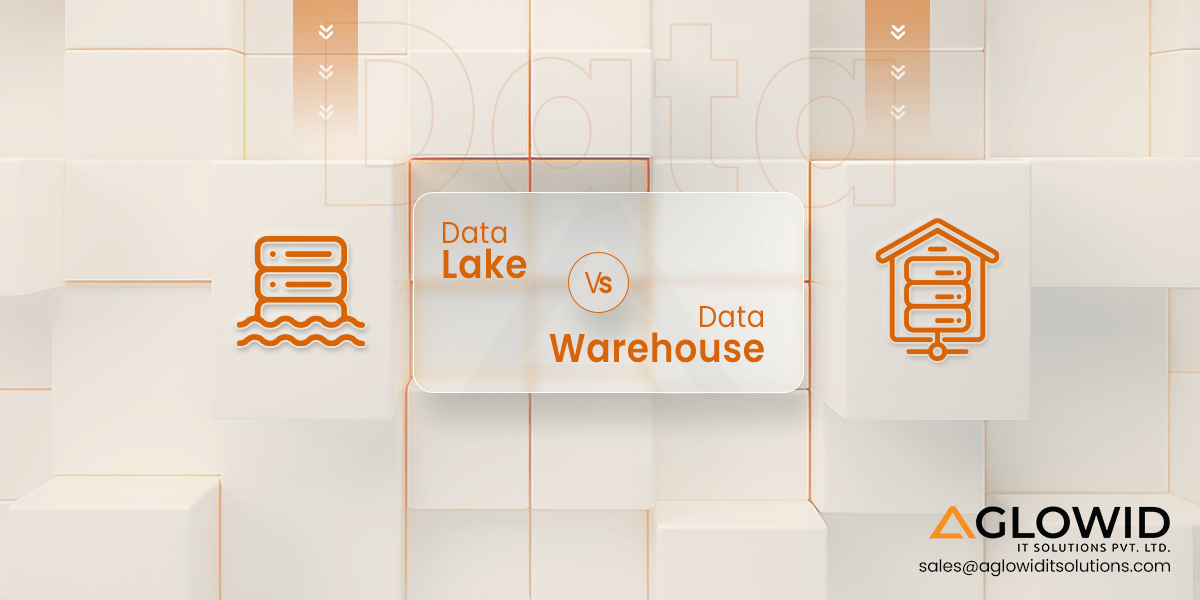




 Say
Say